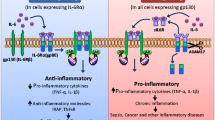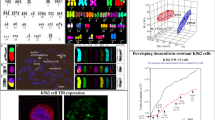Abstract
The lysophospholipids sphingosine-1-phosphate (S1P) and lysophosphatidic acid (LPA) are small lipid molecules with a variety of physiological roles. Additionally, their involvement in the initiation and progression of malignant tumors has been increasingly recognized in recent years. However, the data on the expression of S1P and LPA receptors on different cancer cells are very few. Real-time polymerase chain reaction was used for the analysis of mRNA expression of five S1P(1–5) and three LPA(1–3) receptors on a large panel of 13 colon, breast, melanoma, and lung cancer cell lines. Furthermore, the modulation of S1P and LPA receptor mRNA expression was studied upon xenotransplantation of tumor cells into severe combined immunodeficient (SCID) mice. The S1P and LPA receptors were expressed to a variable degree on all tumor cell lines tested (with exception of colon cancer SW480). Most notably, tumor cell lines in vitro expressed S1P2 mRNA that was down-regulated upon xenotransplantation, whereas LPA2 receptor mRNA was strongly expressed both in vitro and in vivo (except by breast cancer cells). The latter was especially distinctive for small cell lung tumor cells. The S1P and LPA receptors are differentially expressed on tumor cell lines in vitro. Their expression is modulated upon xenografting into SCID mice in vivo.




Similar content being viewed by others
References
Meyer zu Heringdorf D, Jakobs KH. Lysophospholipid receptors: signalling, pharmacology and regulation by lysophospholipid metabolism. Biochim Biophys Acta. 2007;1768:923–40.
Rivera R, Chun J. Biological effects of lysophospholipids. Rev Physiol Biochem Pharmacol. 2008;160:25–46.
Ishii I, Fukushima N, Ye X, Chun J. Lysophospholipid receptors: signaling and biology. Annu Rev Biochem. 2004;73:321–54.
Mills GB, Moolenaar WH. The emerging role of lysophosphatidic acid in cancer. Nat Rev Cancer. 2003;8:582–91.
Balthasar S, Samulin J, Ahlgren H, Bergelin N, Lundqvist M, Toescu EC, et al. Sphingosine 1-phosphate receptor expression profile and regulation of migration in human thyroid cancer cells. Biochem J. 2006;398:547–56.
Yamashita H, Kitayama J, Shida D, Yamaguchi H, Mori K, Osada M, et al. Sphingosine 1-phosphate receptor expression profile in human gastric cancer cells: differential regulation on the migration and proliferation. J Surg Res. 2006;130:80–7.
Dolezalova H, Shankar G, Huang MC, Bikle DD, Goetzl EJ. Biochemical regulation of breast cancer cell expression of S1P2 (Edg-5) and S1P3 (Edg-3) G protein-coupled receptors for sphingosine 1-phosphate. J Cell Biochem. 2003;88:732–43.
Arikawa K, Takuwa N, Yamaguchi H, Sugimoto N, Kitayama J, Nagawa H, et al. Ligand-dependent inhibition of B16 melanoma cell migration and invasion via endogenous S1P2 G protein-coupled receptor. Requirement of inhibition of cellular RAC activity. J Biol Chem. 2003;278:32841–51.
Yamaguchi H, Kitayama J, Takuwa N, Arikawa K, Inoki I, Takehara K, et al. Sphingosine-1-phosphate receptor subtype-specific positive and negative regulation of Rac and haematogenous metastasis of melanoma cells. Biochem J. 2003;374:715–22.
Fang X, Schummer M, Mao M, Yu S, Tabassam FH, Swaby R, et al. Lysophosphatidic acid is a bioactive mediator in ovarian cancer. Biochim Biophys Acta. 2002;1582:257–64.
Sengupta S, Xiao YJ, Xu Y. A novel laminin-induced LPA autocrine loop in the migration of ovarian cancer cells. FASEB J. 2003;17:1570–2.
Xie Y, Gibbs TC, Mukhin YV, Meier KE. Role for 18:1 lysophosphatidic acid as an autocrine mediator in prostate cancer cells. J Biol Chem. 2002;277:32516–26.
Valentiner U, Hall DM, Brooks SA, Schumacher U. HPA binding and metastasis formation of human breast cancer cell lines transplanted into severe combined immunodeficient (scid) mice. Cancer Lett. 2005;219:233–42.
Thies A, Mauer S, Fodstad O, Schumacher U. Clinically proven markers of metastasis predict metastatic spread of human melanoma cells engrafted in scid mice. Br J Cancer. 2007;96:609–16.
Sengupta S, Wang Z, Tipps R, Xu Y. Biology of LPA in health and disease. Semin Cell Dev Biol. 2004;15:503–12.
Onganer PU, Seckl MJ, Djamgoz MB. Neuronal characteristics of small-cell lung cancer. Br J Cancer. 2005;93:1197–201.
Hurst JH, Mumaw J, Machachek DW, Sturkie C, Callihan P, Stice SL, et al. Human neural progenitors express functional lysophospholipid receptors that regulate cell growth and morphology. BMC Neurosci. 2008;9:118. doi:10.1186/1471-2202-9-118.
Cyster JG. Chemokines, sphingosine-1-phosphate, and cell migration in secondary lymphoid organs. Annu Rev Immunol. 2005;23:127–59.
Graeler M, Shankar G, Goetzl EJ. Cutting edge: suppression of T cell chemotaxis by sphingosine 1-phosphate. J Immunol. 2002;169:4084–7.
Wang W, Graeler MH, Goetzl EJ. Physiological sphingosine 1-phosphate requirement for optimal activity of mouse CD4+ regulatory T cells. FASEB J. 2004;18:1043–5.
Fang X, Gaudette D, Furui T, Mao M, Estrella V, Eder A, et al. Lysophospholipid growth factors in the initiation, progression, metastases, and management of ovarian cancer. Ann N Y Acad Sci. 2000;905:188–208.
Qi C, Park JH, Gibbs TC, Shirley DW, Bradshaw CD, Ella KM, et al. Lysophosphatidic acid stimulates phospholipase D activity and cell proliferation in PC-3 human prostate cancer cells. J Cell Physiol. 1998;174:261–72.
Chen M, Towers LN, O'Connor KL. LPA2 (EDG4) mediates Rho-dependent chemotaxis with lower efficacy than LPA1 (EDG2) in breast carcinoma cells. Am J Physiol Cell Physiol. 2007;292:C1927–33.
Kitayama J, Shida D, Sako A, et al. Over-expression of lysophosphatidic acid receptor-2 in human invasive ductal carcinoma. Breast Cancer Res. 2004;6:R640–6.
Horak CE, Lee JH, Elkahloun AG, et al. Nm23-H1 suppresses tumor cell motility by down-regulating the lysophosphatidic acid receptor EDG2. Cancer Res. 2007;67:7238–46.
Horak CE, Mendoza A, Vega-Valle E, et al. Nm23-H1 suppresses metastasis by inhibiting expression of the lysophosphatidic acid receptor EDG2. Cancer Res. 2007;67:11751–9.
Lin S, Wang D, Iyer S, Ghaleb AM, Shim H, Yang VW, et al. The absence of LPA2 attenuates tumor formation in an experimental model of colitis-associated cancer. Gastroenterology. 2009;136:1711–20.
Yamada T, Yano S, Ogino H, Ikuta K, Kakiuchi S, Hanibuchi M, et al. Lysophosphatidic acid stimulates the proliferation and motility of malignant pleural mesothelioma cells through lysophosphatidic acid receptors, LPA1 and LPA2. Cancer Sci. 2008;99:1603–10.
Yu S, Murph MM, Lu Y, Liu S, Hall HS, Liu J, et al. Lysophosphatidic acid receptors determine tumorigenicity and aggressiveness of ovarian cancer cells. J Natl Cancer Inst. 2008;100:1630–42.
Schumacher U, Adam E. Lectin histochemical HPA binding pattern of human breast and colon cancers is associated with metastases formation in SCID mice. Histochem J. 1997;29:677–84.
Mitchell BS, Schumacher U. Use of immunodeficient mice in metastasis research. Br J Biomed Sci. 1997;54:278–86.
Valentiner U, Brooks SA, Schumacher U. In vivo xenograft models of breast cancer metastasis. Meth Mol Med. 2006;120:479–88.
Schumacher U, Mohamed M, Mitchell BS. Differential expression of carbohydrate residues in human breast and colon cancer cell lines grown in vitro and in vivo in SCID mice. Cancer J. 1996;9:247–54.
Wang F, Van Brocklyn JR, Edsall L, Nava VE, Spiegel S. Sphingosine-1-phosphate inhibits motility of human breast cancer cells independently of cell surface receptors. Cancer Res. 1999;59:6185–91.
Sukocheva O, Wadham C, Holmes A, Albanese N, Verrier E, Feng F, et al. Estrogen transactivates EGFR via the sphingosine 1-phosphate receptor Edg-3: the role of sphingosine kinase-1. J Cell Biol. 2006;173:301–10.
Acknowledgment
This work was supported by the Ministry of Science and Technological Development of Republic of Serbia (grant no. 145016). Novica M. Milićević was supported by Alexander von Humboldt-Foundation, Bonn, Germany.
Conflict of interest
The authors declare that they have no conflict of interest.
Author information
Authors and Affiliations
Corresponding author
Rights and permissions
About this article
Cite this article
Müller, R., Berliner, C., Leptin, J. et al. Expression of sphingosine-1-phosphate receptors and lysophosphatidic acid receptors on cultured and xenografted human colon, breast, melanoma, and lung tumor cells. Tumor Biol. 31, 341–349 (2010). https://doi.org/10.1007/s13277-010-0043-7
Received:
Accepted:
Published:
Issue Date:
DOI: https://doi.org/10.1007/s13277-010-0043-7




